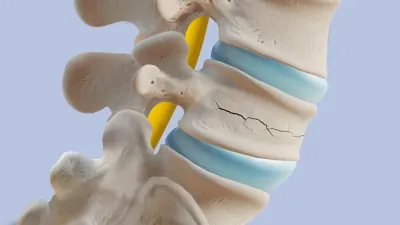
Infrequent Zoledronate Infusions Show Promise in Reducing Vertebral Fracture Risk for Postmenopausal Women
2025-01-20
Author: Li
Study Overview
In a groundbreaking study published in The New England Journal of Medicine, researchers have uncovered that women with healthy bone mineral density (BMD) may significantly decrease their risk of vertebral fractures through occasional infusions of zoledronate between the ages of 50 and 60. This suggests a potential new strategy for postmenopausal women looking to fortify their bone health.
Research Details
Mark Bolland and his team from the University of Auckland, New Zealand, propose that early postmenopausal women can benefit from receiving zoledronate, a drug that is both generic and cost-effective, every 5 to 10 years. This could represent a substantial cost-saving for both patients and healthcare systems.
Study Participants and Methodology
The study involved 1,054 postmenopausal women with an average age of 56, who had an initial BMD T score ranging from -2.5 to 0, indicative of low to normal bone density. Participants were randomly assigned to receive either a 5 mg infusion of zoledronate at the start, followed by a second dose 5 years later, a single infusion followed by placebo, or double placebo.
Findings on Fracture Risk
Remarkably, 95.2% of participants completed a 10-year follow-up, during which new morphometric vertebral fractures were diagnosed in just 6.3% of women receiving two doses of zoledronate, compared to 11.1% for those on double placebo. This led to a significant reduction in fracture risk, with a relative risk of 0.56 for two doses and 0.59 for one dose against double placebo.
Overall Fracture Risk Reduction
Moreover, both dosing regimens demonstrated a marked reduction in the overall fracture risk compared to placebo. Specifically, the risk for any fracture was reduced (RR=0.70 for two doses and 0.77 for one dose), as was the risk for fragility fractures and major osteoporotic fractures.
Changes in Bone Mineral Density
The investigators also assessed BMD changes at the hip and spine over the decade. Notably, women receiving two doses of zoledronate showed an 8.8% increase in bone density compared to placebo, while those receiving one dose had a 6.3% increase. These gains in BMD are crucial, as stronger bones translate to a lower risk of fractures.
Bone Turnover Markers
Additionally, the study tracked bone turnover markers, revealing that levels significantly decreased (by 30-40%) in women who received the drug, contrasting with a rise in markers among placebo recipients. This insight reinforces zoledronate's effectiveness in curbing bone loss.
Safety and Adverse Events
Despite these positive outcomes, the researchers reported minimal adverse events. Some participants experienced mild side effects such as uveitis (1.1% of recipients) but experienced no serious complications such as jaw osteonecrosis or atypical femoral fractures.
Editorial Insights
In an accompanying editorial, Roland Chapurlat of Hôpital E Herriot in Lyon, France, emphasized the importance of these findings, especially considering that vertebral fractures pose significant long-term health risks. He argued that targeting women at lower risk for such fractures could lead to substantial improvements in public health, as approximately 10% of women under 65 are expected to experience a fracture within a decade.
Conclusion and Future Directions
With treatment adherence often challenging for long-term osteoporosis management, Chapurlat suggests that the infrequent dosing regimen of zoledronate could provide a viable solution for primary fracture prevention, steering toward a brighter future in women's health. This promising research not only paves the way for better fracture prevention strategies but also provides hope for countless women seeking to maintain their bone health well into their later years.




 Brasil (PT)
Brasil (PT)
 Canada (EN)
Canada (EN)
 Chile (ES)
Chile (ES)
 Česko (CS)
Česko (CS)
 대한민국 (KO)
대한민국 (KO)
 España (ES)
España (ES)
 France (FR)
France (FR)
 Hong Kong (EN)
Hong Kong (EN)
 Italia (IT)
Italia (IT)
 日本 (JA)
日本 (JA)
 Magyarország (HU)
Magyarország (HU)
 Norge (NO)
Norge (NO)
 Polska (PL)
Polska (PL)
 Schweiz (DE)
Schweiz (DE)
 Singapore (EN)
Singapore (EN)
 Sverige (SV)
Sverige (SV)
 Suomi (FI)
Suomi (FI)
 Türkiye (TR)
Türkiye (TR)
 الإمارات العربية المتحدة (AR)
الإمارات العربية المتحدة (AR)